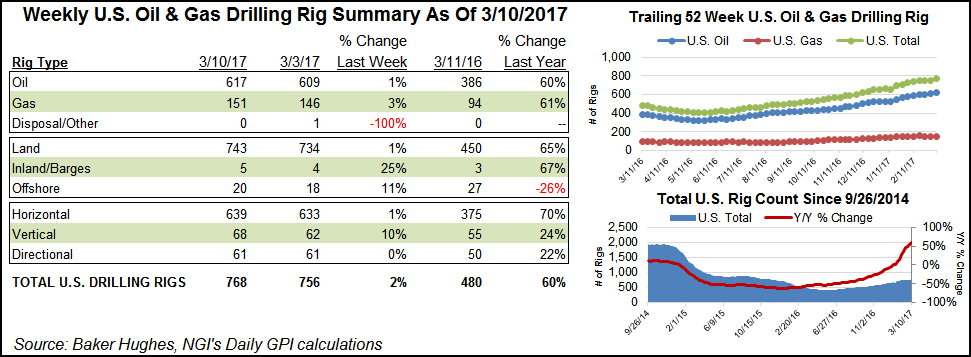Five U.S. NatGas Rigs Return; Texas Well Permitting Up From Year Ago
The United States added nine land-based rigs along with one in the inland waters and two in the offshore to make for a net U.S. gain of one-dozen rigs, according to Baker Hughes Inc. (BHI) in its report for the week ending March 10.

The U.S. gain was more than undone by the loss of 20 rigs in Canada, causing North America to end the week with eight fewer rigs than the previous week.
Eight U.S. oil rigs came back, accompanied by five natural gas rigs; one “miscellaneous” rig left action. Six of the 12 returning U.S. rigs were horizontal units and six were verticals.
Louisiana added five rigs, making it the biggest gainer among states, and the Denver-Julesburg/Niobrara added four rigs, making it the biggest gainer among U.S. plays.
Canada dropped 17 oil and three natural gas rigs. Alberta saw a 4% decline; Saskatchewan was down by 9%, and Manitoba lost five rigs, a 50% decline.
At week’s end there were 743 U.S. land-based rigs running, which is 293 more than a year ago. Overall, there were 768 rigs running in the United States, up 288 from a year ago. Canada had 315 rigs running, up 217 from a year ago. The North America count ended at 1,083, which is 505 more than a year ago.
BHI said on Tuesday the average U.S. rig count for February was 744, up 61 from the 683 counted in January and up 212 from the 532 counted in February 2016. The average Canadian rig count for February was 342, up 40 from the 302 counted in January and up 131 from the 211 counted in February 2016.
The international rig count for February was 941, up eight from the 933 counted in January and down 77 from the 1,018 counted in February 2016. The international offshore rig count for February was 200, down six from the 206 counted in January and down 25 from the 225 counted in February 2016.
The worldwide rig count for February was 2,027, up 109 from the 1,918 counted in January and up 266 from the 1,761 counted in February 2016.
The Railroad Commission of Texas (RRC) issued 991 original drilling permits in February compared to 573 in February 2016. The February total included 847 permits to drill new oil or gas wells, 11 to re-enter plugged wellbores and 133 for recompletions of existing well bores. February permits were for 258 oil, 37 gas, 640 oil or gas, 43 injection, one service and 12 “other” permits.
In February RRC staff processed 533 oil, 95 gas, 49 injection and zero “other” completions compared to 822 oil, 186 gas, 57 injection and one “other” completions in February 2016. Total well completions for 2017 year to date are 1,213; down from 2,270 recorded during the same period in 2016.
© 2024 Natural Gas Intelligence. All rights reserved.
ISSN © 1532-1231 |
